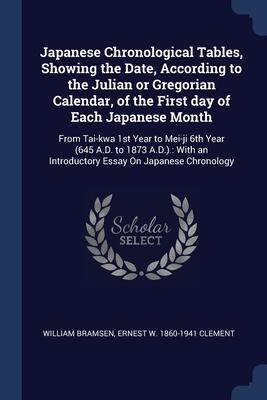
Japanese Chronological Tables, Showing the Date, According to the Julian or Gregorian Calendar, of the First day of Each Japanese Month: From Tai-kwa ... an Introductory Essay On Japanese Chronology
by:
William Bramsen
,
Ernest W 1860-1941 Clement
Language: English
Format: Paperback
ISBN 10: 1376760347
ISBN 13: 9781376760347
Publication date:
February 5th, 2018
Publisher: Sagwan Press
Pages: 334
Genres: History
This scholarly work delves into the intricacies of Japanese chronology, providing readers with a detailed account of the dates corresponding to each month in Japan's historical context. Spanning from the Tai-kwa period, it meticulously outlines the alignment of Japanese dates with the Julian and Gregorian calendars. This fusion of temporal systems offers a richer understanding of Japan's cultural and historical evolution.
The introductory essay serves as a foundation for appreciating the complexities of Japanese timekeeping practices. It discusses the historical significance and the cultural implications of how time has been perceived and recorded throughout Japan's storied past. The authors, William Bramsen and Ernest W. Clement, draw upon extensive research to illuminate the nuances of Japan's calendar systems during different eras.
Scholars and history enthusiasts alike will find the tables invaluable for cross-referencing specific dates across different calendrical frameworks. The work not only serves an academic purpose but also promotes a greater appreciation for Japan's unique historical narrative, making it an essential resource for those interested in the intersection of culture and chronology.
The introductory essay serves as a foundation for appreciating the complexities of Japanese timekeeping practices. It discusses the historical significance and the cultural implications of how time has been perceived and recorded throughout Japan's storied past. The authors, William Bramsen and Ernest W. Clement, draw upon extensive research to illuminate the nuances of Japan's calendar systems during different eras.
Scholars and history enthusiasts alike will find the tables invaluable for cross-referencing specific dates across different calendrical frameworks. The work not only serves an academic purpose but also promotes a greater appreciation for Japan's unique historical narrative, making it an essential resource for those interested in the intersection of culture and chronology.